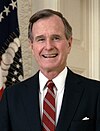Unified Task Force
| Operation Restore Hope | |||||||||||
|---|---|---|---|---|---|---|---|---|---|---|---|
| Part of theSomali Civil War | |||||||||||
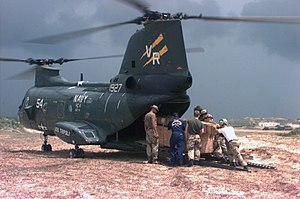 | |||||||||||
| |||||||||||
| Participants | |||||||||||
| Somali National Alliance | |||||||||||
| Commanders and leaders | |||||||||||
| Mohamed Farrah Aidid | |||||||||||
| Casualties and losses | |||||||||||
|
82 killed
~300 wounded
| Several thousand both civilians and military insurgents (per Aidid) | ||||||||||
TheUnified Task Force(UNITAF) was a United States-led, United Nations-sanctioned multinational force which operated inSomaliafrom 5 December 1992 until 4 May 1993. A United States initiative (code-namedOperation Restore Hope), UNITAF was charged with carrying outUnited Nations Security Council Resolution 794to create a protected environment for conducting humanitarian operations in the southern half of the country.
Background[edit]
Faced with ahumanitarian disasterin Somalia, exacerbated by a complete breakdown in civil order, the United Nations had created theUNOSOM Imission in April 1992. However, the complete intransigence of the local faction leaders operating in Somalia and their rivalries with each other meant that UNOSOM I could not be performed. The mission never reached its mandated strength.[4]
Over the final quarter of 1992, the situation in Somalia continued to worsen. Factions were splintering into smaller factions, and then splintered again. Agreements for food distribution with one party were worthless when the stores had to be shipped through the territory of another. Three hundred thousand Somalis had already starved to death, and 1.5 million were at risk of starvation.[5]Some elements were actively opposing the UNOSOM intervention. Troops were shot at, aid ships attacked and prevented from docking, cargo aircraft were fired upon and aid agencies, public and private, were subject to threats, looting and extortion.[4]By November, GeneralMohamed Farrah Aididhad grown confident enough to defy the Security Council formally and demand the withdrawal of peacekeepers, as well as declaring hostile intent against any further UN deployments.[6]
In the face of mounting public pressure and frustration,UN Secretary-GeneralBoutros Boutros-Ghalipresented several options to theSecurity Council.Diplomatic avenues having proved largely fruitless, he recommended that a significant show of force was required to bring the armed groups to heel. Chapter VII of theCharter of the United Nationsallows for "action by air, sea or land forces as may be necessary to maintain or restore international peace and security." Boutros-Ghali believed the time had come for employing this clause and moving on from peacekeeping.[7]

However, Boutros-Ghali felt that such action would be difficult to apply under the mandate for UNOSOM. Moreover, he realised that solving Somalia's problems would require such a large deployment that the UN Secretariat did not have the skills to command and control it. Accordingly, he recommended that a large intervention force be constituted under the command of member states but authorised by the Security Council to carry out operations in Somalia. The goal of this deployment was "to prepare the way for a return to peacekeeping and post-conflict peace-building".[4]
Following this recommendation, on 3 December 1992 the Security Council unanimously adoptedResolution 794,authorizing the use of "all necessary means to establish as soon as possible a secure environment for humanitarian relief operations in Somalia". The Security Council urged the Secretary-General and member states to make arrangements for "the unified command and control" of the military forces that would be involved.[8]
UNITAF has been considered part of a larger state building initiative in Somalia, serving as the military arm to secure the distribution of humanitarian aid. However, UNITAF cannot be considered a state building initiative due to its specific, limited and palliative aims, which it nonetheless exercised forcefully. The primary objective of UNITAF was security rather than larger institution building initiatives.[9]
Composition[edit]
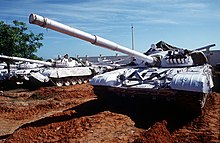
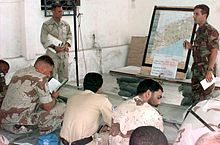

The vast bulk of UNITAF's total personnel strength was provided by the United States (some 25,000 out of a total of 37,000 personnel). Other countries that contributed to UNITAF were1st Battalion, Royal Australian RegimentfromAustralia(January-May 1993),Bangladesh,Belgium,Botswana,Canada,Egypt(one battalion), Ethiopia,France(brigade HQ and one battalion),Germany,Greece(medical company at Waajid), theIndian Army(brigade HQ at Baidoa and three battalions), Ireland (transport company), Italy, Kuwait, Morocco, elements ofNo. 40 Squadron RNZAFfrom New Zealand, Nigeria, Norway, Pakistan, Saudi Arabia, Spain, Sweden, Tunisia, Turkey, United Arab Emirates, the United Kingdom, and Zimbabwe.[10]
For UNITAF, "the task of organizing and subordinating the units became largely a negotiation between the supplying governments and the JTF staff."[11]
TheU.S. Central Command(USCINCCENT) established Joint Task Force (JTF) Somalia to perform Operation Restore Hope. TheI Marine Expeditionary Force(I MEF) staff made up the core of the JTF headquarters. (The name of this command started as CJTF Somalia but changed to United Task Force-UNITAF). The CJTF commanded Marine forces from I MEF (referred to as MARFOR Somalia) and Army forces from the 10th Mountain Division(referred to as ARFOR Somalia), as well as Air Force and Navy personnel and units.[12]There were also special operations forces components, in addition to the forces provided by countries contributing to the US-led, combined coalition.
The national contingents were co-ordinated and overseen byU.S. Central Command,however, the relationship between CentCom and the contributing nations varied. There were a few confrontations over the methods and mandates employed by some contingents. For example, the Italian contingent was accused of bribing local militias to maintain peace, whilst theFrench Foreign Legiontroops were accused of over-vigorous use of force in disarming militiamen.[13]The Canadian contingent of the operation was known by the Canadian operation nameOperation Deliverance.
"The deck was stacked against UNOSOM II, to some extent, from the beginning. The US was anxious to leave, feeling they had accomplished their somewhat limited objectives, but the UN was far from ready to receive the baton. The US, which had planned for a five or six weeks mission when it agreed to head UNITAF, was ready to turn over the command by mid-January. As the UNITAF commander was able to assign humanitarian relief sectors (HRS) to non-US forces, he began—with the approval of CINCCENT and the JCS—to reduce US forces and redeploy them to their home bases. In his words,Lieutenant GeneralRobert B. Johnston[commander I MEF] “knew his mission had been accomplished” and was waiting for the UN to assume the greater mission formally. However,United Nations Security Council Resolution 814authorizing UNOSOM II was not passed until late March, and the first staff members were not in place and ready to start the transition until April. "[14]
United States[edit]
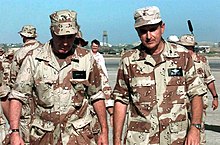
Prior to Resolution 794, the United States had approached the UN and offered a significant troop contribution to Somalia, with the caveat that these personnel would not be commanded by the UN. Resolution 794 did not specifically identify the U.S. as being responsible for the future task force, but mentioned "the offer by a Member State described in the Secretary-General's letter to the Council of 29 November 1992 (S/24868) concerning the establishment of an operation to create such a secure environment".[15]Resolution 794 was unanimously adopted by the United Nations Security Council on 3 December 1992, and they welcomed the United States offer to help create a secure environment for humanitarian efforts in Somalia.[16]PresidentGeorge H. W. Bushresponded to this by initiating Operation Restore Hope on 4 December 1992, under which the United States would assume command in accordance with Resolution 794.[17]
Larry Freedman, aCIAparamilitary officer from theSpecial Activities Division,became the first U.S. casualty of the conflict in Somalia when his vehicle struck ananti-tank mine.He had been inserted prior to official U.S. presence on a special reconnaissance mission, serving as a liaison between the U.S. Embassy and the arriving military forces while providing intelligence for both. The first Marines of UNITAF landed on the beaches of Somalia on 9 December 1992 amid amedia circus.The press "seemed to know the exact time and place of the Marines' arrival" and waited on the airport runway and beaches to capture the moment.[18]
Critics of U.S. involvement argued that the U.S. government was intervening so as to gain control of oil concessions for American companies,[19]with a survey of Northeast Africa by the World Bank and UN ranking Somalia second only toSudanas the top prospective producer.[20]However, no American and UN troops were deployed in proximity to the major oil exploration areas in the northeastern part of the country or the autonomousSomalilandregion in the northwest. The intervention happened twenty-two months after the fall of Barre's regime.[21]Other critics explain the intervention as the administration's way to maintain the size and expenditures of the post-Cold War military establishment, to deflect criticism for the president's failure to act inBosnia,or to leave office on a high note.[21]To many in the administration, the intervention seemed like an optimal case for the use of military force – the chances of success seemed high, while the political risks and the danger to U.S. troops appeared to be limited. Acting Secretary of StateEagleburgerdescribed the situation in Somalia as "a tragedy of massive proportions, and, underline this, one that we could do something about.”[22]
Operation[edit]
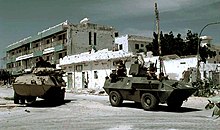
The operation began on 6 December 1992, whenNavy SEALsandspecial warfare combatant-craft crewmenfrom Naval Special Warfare Task Unit TRIPOLI began conducting beach and port hydrographic and reconnaissance survey operations in the vicinity of the landing beach, airport, and harbor. These operations lasted three days. In the early hours of 8 December 1992, elements of the4th Psychological Operations Groupattached to the15th Marine Expeditionary Unit(MEU) conducted leaflet drops over the capital city ofMogadishu.[23][24]At 0540, on 9 December, the MEU performed a combined methods of entryamphibious assaultinto the city of Mogadishu and surrounding areas fromUSSTripoli,USSJuneau,andUSSRushmore.[25][26]Although initially unopposed, the uncertain operating environment required using nonlinear, simultaneous forcible entry operations along multiple lines of operation from selected afloat and ashore basing throughout the amphibious operations area.[27]
The MEU'sground combat element,Battalion Landing Team (BLT) 2nd Battalion, 9th Marines(2/9) along with Delta Battery 2nd Battalion 12th Marines, performed simultaneous ship to objective amphibious assaults on the Port of Mogadishu and Mogadishu International Airport, establishing a foothold for additional incoming troops.[28]Echo and Golf Company assaulted the airport by helicopter andAmphibious Assault Vehicles,while Fox Company secured the port with aneconomy of forcerubber boat assault. The 1st Marine Division's Air Contingency Battalion (ACB),1st Battalion, 7th Marines,as well as 3rd Battalion, 11th Marines (3/11 is an artillery battalion but operated as a provisional infantry battalion while in Somalia), arrived soon after the airport was secured. Elements of BLT 2/9's India Co, and 1/7 went on to secure the airport inBaidoaand the city ofBardera,while BLT 2/9's Golf Company, and elements of the Belgian Special Forces, conducted an amphibious landing at the port city ofKismayo.Air support was provided by the combined helicopter units ofHMLA-267,HMH-363,HMH-466,HMM-164,and HC-11's DET 10.
Concurrently, various Somali factions returned to the negotiating table in an attempt to end the civil war. This effort was known as theConference on National Reconciliation in Somaliaand it resulted in theAddis Ababa Agreementsigned on 27 March 1993.[29]The conference, however, had little result as the civil war continued afterwards.
Results[edit]

As UNITAF's mandate was to protect the delivery of food and other humanitarian aid, the operation was regarded as a success.[30]United Nations Secretary-GeneralBoutros Boutros-Ghalidetermined that the presence of UNITAF troops had a "positive impact on the security situation in Somalia and on the effective delivery of humanitarian assistance."[31]An epidemiological survey determined approximately 10,000 lives had been saved by the military intervention. While UNITAF saw a dramatic increase in the scope of the military intervention, no more lives were saved compared toUNOSOM I.The primary reason was due to the sharp decline in mortality rates during October 1992, before the large scale deployment of troops. Studies on the intervention noted that UNITAF had the effect of speeding up the famines conclusion by about a month.[32]According to an assessment by theWashingtonbased independentNGORefugee Policy Group, only 10,000 to 25,000 lives of the approximately 100,000 rescued by international assistance had been saved by the UNITAF and UNOSOM II interventions, and according to ProfessorAlex de Waalthe true figure may have been even lower.[33][34]Figures like Secretary-GeneralBoutros-Ghaliand American diplomatChester Crockerclaimed that the intervention saved a quarter of a million Somali lives,[35]a claim which has been disputed by other observers who have noted that there is minimal evidence to suggest that UNITAF had had any significant impact on mortality.[32]
Operation Continue Hope provided support of UNOSOM II to establish a secure environment for humanitarian relief operations by providing personnel, logistical, communications, intelligence support, a quick reaction force, and other elements as required. Navy ships were involved, from the unit USS PeleliuAmphibious Readiness Group.The ships included the shipUSS Anchorage,USS Peleliu,USS Duluth,USS Frederick.The Marine units from 11th Marine Expeditionary Unit (MEU) were involved. The USS Anchorage docked at the port of Mogadishu and spent several days there. Over 60 Army aircraft and approximately 1,000 aviation personnel operated in Somalia from 1992 to 1994.
No disarmament of the rivalling factions within Somalia was undertaken.[36]This meant that the situation stayed stable only for the time UNITAF's overwhelming presence was deterring the fighting. Therefore, the mandate to create a "secure environment" was not achieved in a durable fashion. TheCanadian Airborne Regimentwas disbanded due to its conduct at UNITAF that was revealed during an investigation into theSomalia Affair.[citation needed]
Transition to UNOSOM II[edit]

UNITAF was only intended as a transitional body.[citation needed]Once a secure environment had been restored, the suspended UNOSOM mission would be revived, albeit in a much more robust form. On 3 March 1993, the Secretary-General submitted to the Security Council his recommendations for effecting the transition from UNITAF toUNOSOM II.He noted that despite the size of the UNITAF mission, a secure environment was not yet established and there was still no effective functioning government or local security/police force.[4] The Secretary-General concluded therefore, that, should the Security Council determine that the time had come for the transition from UNITAF to UNOSOM II, the latter should be endowed with enforcement powers under Chapter VII of the United Nations Charter to establish a secure environment throughout Somalia.[4]The operation would therefore seek to complete the task begun by UNITAF for the restoration of peace and stability in Somalia. The new mandate would also empower UNOSOM II to assist the Somali people in rebuilding their economic, political and social life, through achieving national reconciliation so as to recreate a democratic Somali State.[citation needed]UNOSOM II was established by the Security Council inResolution 814on 26 March 1993 and formally took over two months later.[37]
One day prior to the signing of theAddis Ababa Agreement,theUnited Nations Security CouncilpassedResolution 814,which marked the transfer of power from UNITAF toUNOSOM II,a United Nations led force. The major change in policy that the transition from UNITAF to UNOSOM II entailed is that the new mandate included the responsibility ofnation-buildingon the multinational force.[38]On 3 May 1993, UNOSOM II officially assumed command, and on 4 May 1993 it assumed responsibility for the operations. Despite UNOSOM II being composed of a coalition of twenty-seven countries, most of the decision makers were still Americans, giving the United States significant control over much of the operation.[39][40]Marine Lt. Gen.Robert B. Johnston,head of UNITAF, would state that although in his view UNITAF had been success US efforts and losses would be in vain if UNOSOM II was also not successful.[40]UNOSOM II Force CommanderCevik Biropenly admitted that the critical posts in his headquarters were manned by Americans by May 1993,[40]and it was observed that very few nations involved had any representation in the UN military command structure.[39][41]In addition to this the representative of theUN Secretary-Generalin Somalia and head of UNOSOM II, retired US AdmiralJonathan Howe,staffed his headquarters with twenty-eight US officers in key positions. Months into the operation, following the5 June 1993 killings of the Pakistanisand the passing ofUNSCR 837,the US would effectively take lead of the mission.[39]
References[edit]
Footnotes[edit]
- ^"The United States Army in Somalia, 1992-1994 | U.S. Army Center of Military History".
- ^"United Nations Operation in Somalia UNSOM 1992".Australian War Memorial.Retrieved31 May2009.
- ^"American War and Military Operations Casualties: Lists and Statistics"(PDF).Fas.org.Retrieved4 October2018.
- ^abcde"United Nations Operation In Somalia I – (Unosom I)".Un.org.Retrieved29 January2012.
- ^Clarke, Walter (1997).Learning from Somalia: The Lessons of Armed Humanitarian Intervention(1st ed.). Boulder, CO: Westview Press. p. 155.ISBN9780813327938.
- ^United Nations, 1992, Letter dated 92/11/24 from the Secretary-General addressed to the President of the Security Council.
- ^United Nations, 1992, Letter dated 92/11/29 from the Secretary-General addressed to the President of the Security Council, page 6.
- ^United Nations, Security Council resolution 794 (1992), 24 April 1992, para. 3
- ^Caplan, Richard (2012).Exit Strategies and State Building.New York: Oxford University Press. p. 86.ISBN978-0199760121.
- ^"UNITED NATIONS OPERATION IN SOMALIA II (UNOSOM II) - Background (Summary)".peacekeeping.un.org.Retrieved16 September2021.;Ramsbothan and Woodhouse, 1999, 225.
- ^Bullock 1995,https:// airuniversity.af.edu/AUPress/SAASS-Theses/smdpage15021/6/
- ^Relations with Humanitarian Relief Organizations: Observations from Restore Hope, Center for Naval Analysis
- ^Patman, R.G., 2001, ‘Beyond ‘the Mogadishu Line’: Some Australian Lessons for Managing Intra-State Conflicts’,Small Wars and Insurgencies,Vol, 12, No. 1, p. 69
- ^Bullock 1995,https:// airuniversity.af.edu/AUPress/SAASS-Theses/smdpage15021/6/
- ^"Security Council resolutions – 1992".Un.org.Retrieved29 January2012.
- ^Security Council Resolution 794
- ^Bush, George H., Address to the Nation on the Situation in Somalia, 4/12/92 On 23 December 1992,
- ^Johnston, Dr. Philip (1994).Somalia Diary: The President of CARE Tells One Country's Story of Hope.Atlanta, Georgia: Longstreet Press. p. 73.ISBN1-56352-188-1.
- ^Fineman, Mark (18 January 1993)."Column One; The Oil Factor In Somalia;Four American Petroleum Giants Had Agreements With The African Nation Before Its Civil War Began. They Could Reap Big Rewards If Peace Is Restored".Los Angeles Times:1. Archived fromthe originalon 24 February 2012.
- ^Hassan, Abdiqani (21 May 2008)."Canada's Africa Oil starts Somalia seismic survey".Reuters.Retrieved26 August2020.
- ^abAdam, Dr. Hussein M. (2008).From Tyranny to Anarchy: The Somali Experience.Trenton, NJ: The Red Sea Press, Inc. pp. 156–160.ISBN978-1-56902-288-7.
- ^Baum, Matthew A. (June 2004). "How Public Opinion Constrains the Use of Force: The Case of Operation Restore Hope".Presidential Studies Quarterly.34(2): 187–226.doi:10.1111/j.1741-5705.2004.00028.x.ISSN0360-4918.
- ^Friedman, Herbert A."United States PSYOP in Somalia".Psywarrior.Retrieved2 December2012.
- ^Borchini, Charles P. (Lt. Col.); Borstelmann, Mari (October 1994)."PSYOP in Somalia: The Voice of Hope"(PDF).Special Warfare.United States Army.Retrieved2 December2012.[permanent dead link]
- ^Buer, Eric F. (Maj.) (2002)."A Comparative Analysis of Offensive Air Support"(PDF).United States Marine Corps Command and Staff College. p. 23.Archived(PDF)from the original on 12 August 2014.
- ^Mroczkowski, Dennis P. (Col.) (2005).Restoring Hope: In Somalia with the Unified Task Force 1992–1993(PDF).United States Marines Corps. pp. 31–34.Retrieved13 February2020.
- ^Joint Publication 3-0 (17 January 2017).Joint Operations(Incorporating Change 1, 22 October 2018 ed.). Joint Chiefs of Staff: US Government Printing Office. pp. V-17 to V-18, VIII-12 to VIII-13, GL-10.
{{cite book}}:CS1 maint: numeric names: authors list (link) - ^Joint Publication 3-02 (4 January 2019)."Chapter II – Types of Amphibious Operations, Chapter IV – Planning Phase"(PDF).Amphibious Operations.Joint Chiefs of Staff: US Government Printing Office. pp. II-9 to II-13, IV-4 to IV-19.
{{cite book}}:CS1 maint: numeric names: authors list (link) - ^"The General Agreement signed in Addis Ababa on 8 January 1993".United States Institute of Peace. Archived fromthe originalon 29 December 2006.Retrieved30 November2019.
- ^"Operation Restore Hope".Globalsecurity.org.Retrieved2 December2007.
- ^"United Nations Operation in Somalia I".Retrieved2 December2007.
- ^abSeybolt, Taylor B. (2012).Humanitarian military intervention: the conditions for success and failure(PDF)(Repr ed.). Solna, Sweden: Sipri, Stockholm International Peace Research Inst. pp. 56–57.ISBN978-0-19-955105-7.
- ^Maren, Michael (1997).The Road to Hell.Free Press. p. 214.ISBN978-0-7432-2786-5.
- ^Funk, Kevin (2009).Scramble for Africa: Darfur-intervention and the USA.Black Rose Books. p. 71.OCLC1342130779.
- ^Crocker, Chester A. (1995)."The Lessons of Somalia: Not Everything Went Wrong".Foreign Affairs.74(3): 2–8.doi:10.2307/20047117.ISSN0015-7120.JSTOR20047117.
- ^Norrie MacQueen (2006).Peacekeeping and the International System.Routledge.[ISBN missing]
- ^Brune, Lester H. (1998).The United States and Post-cold War Interventions: Bush and Clinton in Somalia, Haiti, and Bosnia, 1992–1998.Regina Books. p. 33.ISBN978-0941690904.
- ^"United Nations Operation in Somalia 2".Un.org.Retrieved2 December2007.
- ^abcBerdal, Mats R. (1994)."Fateful Encounter: The United States and UN peacekeeping".Survival: Global Politics and Strategy.36(1): 30–50.doi:10.1080/00396339408442722.ISSN0039-6338.
- ^abc"US Backs Up UN in Somalia, Protecting Its Investment".Christian Science Monitor.25 May 1993.ISSN0882-7729.Retrieved17 May2023.
- ^Bradbury, Mark (1994).The Somali Conflict: Prospects for Peace.Oxfam.ISBN0-85598-271-3.
Bibliography[edit]
- Allard, Kenneth (1995).Somalia Operations: Lessons Learned(PDF).Washington, DC:National Defense University Press.ISBN978-0160455773.OCLC32155661.Archived fromthe original(PDF)on 8 August 2022.
- Harned, Glenn M. (2016).Stability Operations in Somalia 1992-1993: A Case Study(PDF).Carlisle Barracks,PA:United States Army War College:Peacekeeping and Stability Operations Institute.ISBN978-0-9861865-8-5.Archived fromthe original(PDF)on 17 April 2018.Retrieved8 August2022.
- Miller, Laura L.; Moskos, C. (1995). "Humanitarians or Warriors?: Race, Gender, and Combat Status in Operation Restore Hope".Armed Forces & Society.21(4): 615–637.doi:10.1177/0095327x9502100406.S2CID144654522.
- Poole, Walter S. (2005)."The Effort to Save Somalia August 1992-March 1994"(PDF).Joint History Office ofJoint Chiefs of Staff.Archived fromthe original(PDF)on 29 May 2022.Retrieved7 August2022.
- Stevenson, Jonathan (1995).Losing Mogadishu: Testing U.S. Policy in Somalia.Annapolis, MD:Naval Institute Press.ISBN978-1557507884.
- Stewart, Richard W. (2003)."The United States Army in Somalia 1992-1994".United States Army Center of Military History.Archived fromthe originalon 19 June 2022.Retrieved6 August2022.
- The United Nations and Somalia 1992-1996.The United Nations Blue Book Series. Vol. VIII. New York, NY:United NationsDepartment of Public Information.1996.ISBN978-92-1-100566-0.Archived fromthe originalon 8 August 2022.Retrieved8 August2022.
- "United States Forces, Somalia After Action Report and Historical Overview: The United States Army in Somalia, 1992–1994"(PDF).United States Army Center of Military History.2003. Archived fromthe original(PDF)on 1 August 2022.Retrieved7 August2022.
External links[edit]
- UN Department of Peacekeeping: UNOSOM 1Archived
- UN Department of Peacekeeping: UNOSOM 2Archived
- Global Security on Operation Restore HopeArchived
- Bibliography of Contingency Operations: Somalia (Restore Hope)compiled by theU.S. Army Center of Military History,Archived
- Battles involving Botswana
- Humanitarian military operations
- Military operations involving Australia
- Military operations involving Belgium
- Military operations involving India
- Military operations involving Italy
- Military operations involving Malaysia
- Military operations involving New Zealand
- Military operations involving Pakistan
- Military operations involving the United Kingdom
- Military operations involving the United States
- Pakistan military presence in other countries
- Military operations of the Somali Civil War
- Somalia–United States relations
- United Nations operations in Somalia
- United Nations Security Council subsidiary organs
- United States Marine Corps in the 20th century


